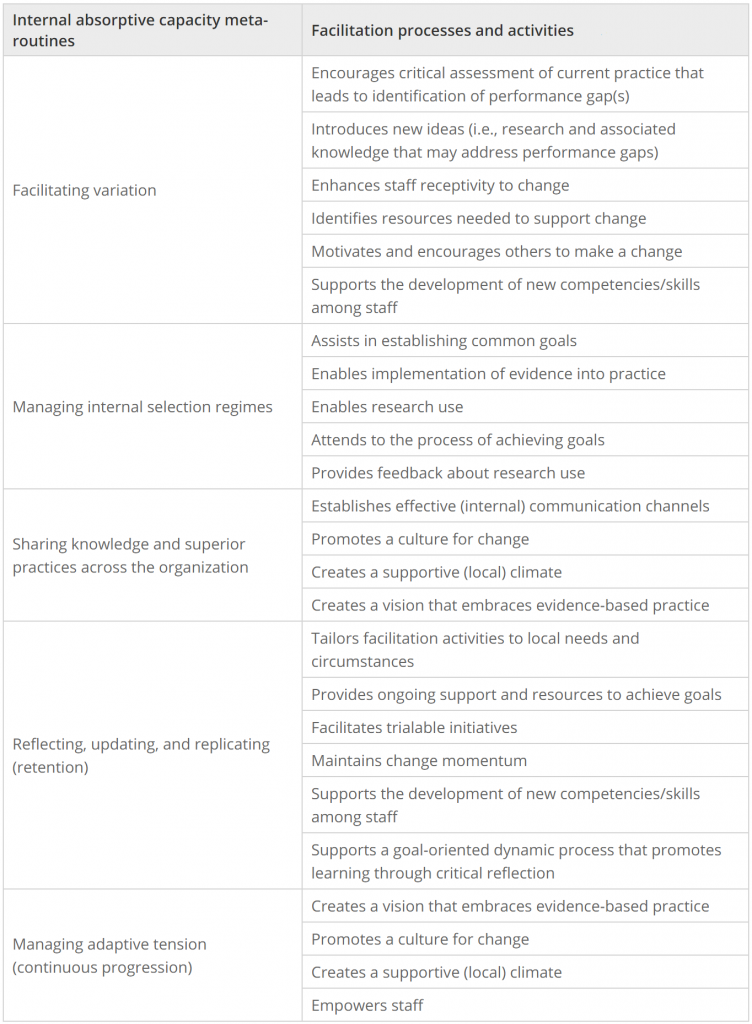
International Facilitation Week: The role of facilitation in evidence-based practice
International Facilitation Week (IFW) is held in October every year, with the current IFW running from 17 to 23 October 2016. IFW is an initiative of the International Association of Facilitators (IAF) and was first held in 2013. The purpose of IFW “is to showcase the power of facilitation to both new and existing audiences and to create a sense of community among facilitators and their groups worldwide.”
With the purpose of RealKM Magazine being to encourage evidence-based practice in knowledge management, we are marking IFW with an exploration of the role of facilitation in evidence-based practice. Much of the research base in regard to this comes from the field of health care.
A highly cited 2002 study1 presents the findings of a concept analysis of facilitation in regard to the successful implementation of evidence into practice. The study found that the concept of facilitation was only partially developed, and in need of delineation and comparison.
The study puts forward defining aspects of facilitation that distinguish it from other change agent strategies, and proposes that facilitation occurs somewhere along a set of continua, depending on the purpose of the facilitation.
Defining aspects of the facilitator role are:
- it is an appointed role as opposed to that of, for example, an opinion leader who through their own personal reputation and influence acts as a change agent
- this role may be internal or external (or encompass a combined internal/external approach) to the organization in which the change is being implemented
- the role is about helping and enabling rather than telling or persuading
- within the concept of helping/enabling, the focus of facilitation can encompass a broad spectrum, ranging from the provision of help to achieve a specific task to using methods which enable individuals and teams to review their attitudes, habits, skills, ways of thinking and working
- given the broad focus of the facilitation concept, a wide range of facilitator roles are possible, with corresponding skills and attributes needed to fulfill the role effectively.
The set of continua representing facilitation are shown in Figure 1 below.

Moving forward from 2002 to the present day, a recent study states that while facilitation is now a popular concept, the content of facilitation and its impact on knowledge implementation varies, and the basis for this is poorly understood.
This 2015 study2 argues “that our understanding of facilitation and its effects is limited in part by a lack of clear theoretical grounding”, and proposes a theoretical home for facilitation in organizational learning theory. The study finds that:
The varied effectiveness of facilitation observed in the literature is associated with the presence or absence of factors known to influence organizational learning, since facilitation itself appears to act as a learning mechanism.
The study offers ten propositions that develop mappings between facilitation micro-processes and key organizational learning concepts:
- Proposition 1: Facilitation is a social integration mechanism that leads to realizing (latent) absorptive capacity potential in health services organizations.
- Proposition 2: Facilitation influences the learning meta-process of variation-selection-retention of new knowledge.
- Proposition 3: Facilitation micro-processes and activities (introducing new ideas, establishing effective communication channels, engaging in networking, and identifying suppliers of new competencies and skills) comprise external absorptive capacity meta-routines.
- Proposition 4: Facilitation micro-processes and activities (encouraging assessment of current practice, introducing new ideas, enhancing staff receptivity to change and encouraging or motivating them to make change, identifying resources for change, motivating others to make a change, introducing new ideas internal to the organization, and supporting development of new staff competencies and skills) comprise internal absorptive capacity meta-routines for facilitating variation.
- Proposition 5: Facilitation micro-processes and activities (assisting in establishing common goals, enabling the implementation of research findings into practice, attending to the process of achieving goals, and providing feedback about research use) comprise internal absorptive capacity meta-routines for managing internal selection regimes.
- Proposition 6: Facilitation micro-processes and activities (establishing effective communication channels, empowering staff, promoting positive changes in culture or climate, and creating a vision that embraces evidence-based practice) comprise internal absorptive capacity meta-routines for sharing knowledge and superior practices across the organization.
- Proposition 7: Facilitation micro-processes and activities (tailoring facilitation activities to local needs and circumstances, providing ongoing support and resources to achieve goals, facilitating trialable initiatives, maintaining change momentum, supporting development of new competencies and skills, and supporting a goal-oriented dynamic process that promotes learning through critical reflection) comprise internal absorptive capacity meta-routines for reflecting, updating, and replicating.
- Proposition 8: Facilitation micro-processes and activities (creating a vision that embraces evidence-based practice, promoting a culture for positive change, creating a supportive local climate) comprise internal absorptive capacity meta-routines for managing adaptive tension.
- Proposition 9: Facilitation micro-processes and activities that relate to the internal absorptive capacity meta-routines of reflecting, updating and replicating can lead to higher-order, double-loop organizational learning.
- Proposition 10: Facilitation micro-processes and activities that relate to the internal absorptive capacity meta-routines of reflecting, updating, and replicating and managing adaptive tension can lead to triple-loop learning.
Table 1 maps facilitation processes and activities to external absorptive capacity meta-routines, and Table 2 maps facilitation processes and activities to internal absorptive capacity meta-routines.


RealKM Magazine has previously published a case study showing how facilitation can be used to assist collaborative learning.
References:
- Harvey, G., Loftus‐Hills, A., Rycroft‐Malone, J., Titchen, A., Kitson, A., McCormack, B., & Seers, K. (2002). Getting evidence into practice: the role and function of facilitation. Journal of advanced nursing, 37(6), 577-588. ↩
- Berta, W., Cranley, L., Dearing, J. W., Dogherty, E. J., Squires, J. E., & Estabrooks, C. A. (2015). Why (we think) facilitation works: insights from organizational learning theory. Implementation Science, 10(1), 1. ↩
Also published on Medium.






